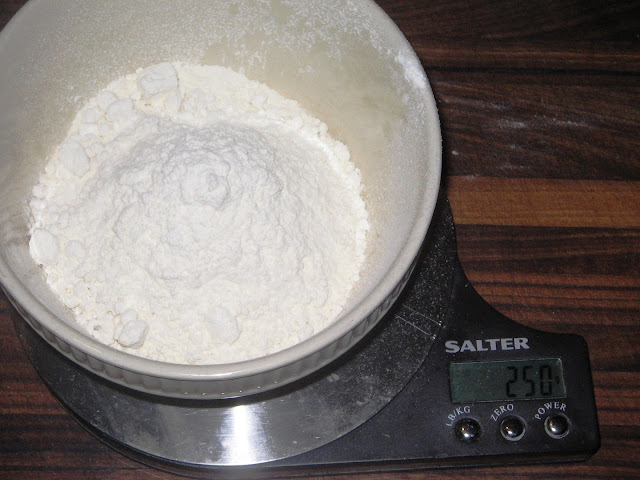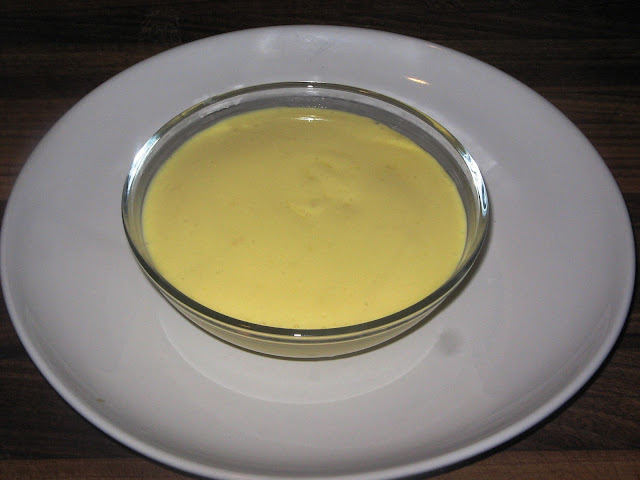I am very excited to be past the Basics chapter and on to actual baking. Even better, I am starting with a type of small cake called a Baba. Baba was the nickname of my grandmother, and she was just awesome. Hopefully, this would make her proud.
Today I was on another dead-end wild goose chase that absorbed far too much time (to be covered in the next entry), so I only accomplished the first two out of the five baba recipes. The first was the Quick Baba on page 52.
Babas are usually yeast-risen cakes, but this one relied on baking powder instead. These cakes also have their own mold, the baba mold. I picked up mine at Sur la Table, and they offer a variety of molds. The molds run between 2 and 3.5 inches in height, and also have a variety of diameters. I went with molds that were 2.5 inches tall and about that same measurement across.
The molds need to be buttered on the inside for easy release later.
The liquids are whisked together in a mixing bowl to begin the recipe.
The dry ingredients follow, after being sifted.
Mix together, and you are ready to fill the molds.
Which brought me to my first problem...I knew these things were going to rise, I just didn't know how much. As this was my first baba recipe, I used this opportunity to fill the molds to different heights to experiment.
As you can see, filling them to different heights yielded quite different results.
Some results were ridiculous.
It was time to introduce the Syrup for Babas that I created in the previous post. At this point, I had a little bit of foresight, and moved the babas to another cookie sheet that I had lined with aluminum foil. I anticipated the syrup running all over the place, so I wanted to use the foil for easy cleaning.
Here is one of the correctly-sized babas. The goal is the drizzle the syrup over the top so that it falls in that small gap around the edges and the baba soaks up the syrup all over.
Here is my first final baked product!
This tasted like a biscuit. Reflecting on the recipe, it is very close to a biscuit, especially since it lacks any kind of sweetener and the batter is very thick.
I enjoyed having some sort of reference scale as a note in my book, so in that spirit here is the scale that I will tentatively use, and probably modify as I go along (final result will be in bold):
What the heck was that?
Meh.
Interesting, glad I tried it, but won't go back to try this again.
Good, but not repeat-worthy.
Very good, with some modifications this could be seen again.
This is company-worthy.
The second recipe today was the Rum Baba from Lorraine on page 53.
This time I got a little smarter...I lined the baking sheet with aluminum foil right away so that I only had to clean one sheet. The molds were buttered and I was ready to start mixing the batter.
Order was backwards for this recipe, with the dry ingredients being mixed together first.
The dry ingredients are sifted into a mixing bowl. The next step was to make a "well" in the dry ingredients to hold the wet stuff. I generally grow impatient with this technique, so I learned to use the mixing bowl for my stand mixer.
The wets were added in and I dug out the dough hook for my stand mixer.
Thanks to the first recipe's experiment, this time I knew how much batter to place into the molds. I also used the back of a spoon to smooth out the tops to enhance the final appearance.
Perfect!
I got out the rum syrup, and then had a thought....
The margin of error is small, and in the previous recipe I had some difficulty in controlling the syrup out of my container. Frankly, it ran out too quickly and poured out all over the place.
To remedy this situation, I switched to a smaller container with a much smaller opening. This gave me significantly superior control.
I liked the way these turned out!
This recipe is SO much better than the first one. Texture was smoother, the interior was fluffier and much less dense, and flavor was yummier. Also, the addition of sugar helped to make this taste much more like a cake.
What the heck was that?
Meh.
Interesting, glad I tried it, but won't go back to try this again.
Good, but not repeat-worthy.
Very good, with some modifications this could be seen again.
This is company-worthy.
Meh.
Interesting, glad I tried it, but won't go back to try this again.
Good, but not repeat-worthy.
Very good, with some modifications this could be seen again.
This is company-worthy.

































































